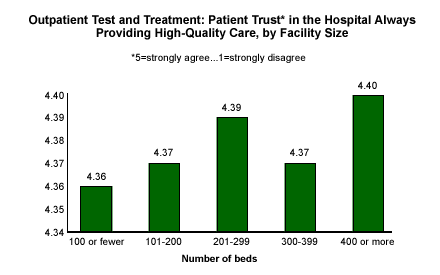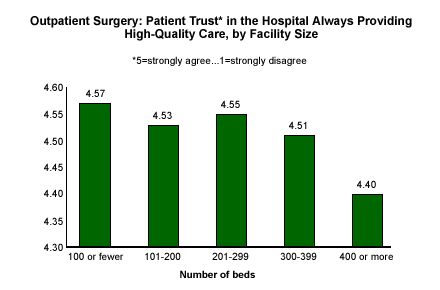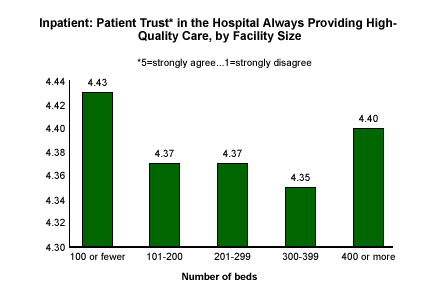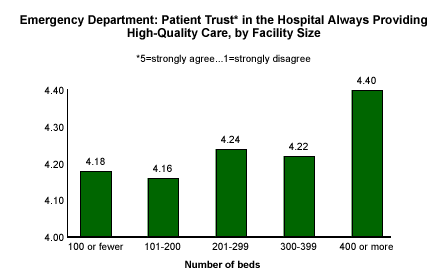First in a series of articles on patient satisfaction by hospital size.
A 2000 Institute of Medicine report, which revealed that medical errors kill up to 98,000 people annually, has clearly raised concerns about patient safety in American hospitals. Reactions to the report from public policy "watchdog" groups were swift. One major initiative, supported by the Leapfrog Group, has been to create "centers of excellence" for certain procedures at larger hospitals, based on evidence that the more specialized hospitals or physicians become at certain procedures, the greater the quality of those procedures.
Measuring the effect of such initiatives may be complicated by the fact that clinical outcomes data are often weighted to compensate for variations in hospital size, patient mix, or geographic location. Yet such factors can have very real effects on patient perceptions. It's worth asking, for example, do patients tend to feel that larger facilities offer higher quality care than smaller facilities?
Trust in Hospital Quality by Facility Size
Tapping into ║┌┴¤═°'s 2001 patient satisfaction and loyalty database, ║┌┴¤═° researchers examined the possible connection between hospital size and patients' trust that a hospital always provides high-quality care. Overall, the results do not point to a consistent pattern between hospital size and patient perceptions of trust in a hospital's ability to provide high-quality care.

Outpatients
The least differentiation by facility size is found in trust levels for outpatient diagnostic procedures. Size does not have a strong impact on patient perceptions of diagnostic quality.

Hospital size does appear to have a more direct impact on trust in quality for outpatient surgery facilities -- but the pattern is opposite from what one might expect. Trust in outpatient surgery at smaller facilities is higher than it is for larger facilities. This trend could indicate that, for surgical outpatients, convenience of a facility's location is more important to patient perceptions of consistent quality.
Inpatients
One might surmise that there is less direct linkage between facility size and trust in quality at outpatient facilities because outpatient procedures are less complex and easier to perform at smaller facilities. Is there greater linkage between hospital size and trust in the more sophisticated settings of inpatient and emergency care?

With regard to inpatient care, trust quality is greatest among the extremes: hospitals with 100 beds or fewer and with 400 beds or more. There are a number of possible explanations for the higher evaluations of both small and large facilities, with lower scores for facilities between 101 and 399 beds. In the absence of concrete quality indicators, patient evaluations of small facilities may be highly influenced by the personalized care they receive. But patients may also understand the need to receive specialized care at larger facilities. While patients may feel that small facilities provide basic, high-quality inpatient care, they may also select facilities of 400 beds or more for highly specialized care unavailable at smaller facilities.
Emergency Department
Perceptions of emergency department quality appear to correspond most closely with facility size. Lower levels of trust exist for hospitals with 200 or fewer beds. This can be explained in part by a perceived lack of access to specialty physicians and equipment at small facilities when unexpected, urgent healthcare situations arise.

Key Points
Across service sectors, there is no clear linear relationship between perceptions of consistent hospital quality and facility size. With the possible exception of the emergency department, smaller hospitals with appropriate service mixes and technology are generally more likely to be perceived as providing high quality than are larger facilities. This may reflect the fact that smaller hospitals successfully position themselves as having appropriate technology and high levels of patient service. There is some indication in the inpatient and emergency sectors that patients may differentiate between smaller and larger hospitals when there is a need for specialized services. At a minimum, this initial analysis suggests that public support for systematically directing patients to larger hospitals for specialty procedures is unlikely at this time.
Future articles will examine patient satisfaction and likelihood to return to facilities based on their size.